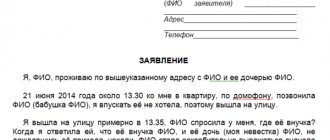1. Illegal use of an invention, utility model or industrial design, disclosure without the consent of the author or applicant of the essence of the invention, utility model or industrial design before the official publication of information about them, appropriation of authorship or coercion of co-authorship, if these acts caused major damage, -
shall be punishable by a fine in the amount of up to two hundred thousand rubles, or in the amount of the wages or other income of the convicted person for a period of up to eighteen months, or by compulsory labor for a term of up to four hundred and eighty hours, or by forced labor for a term of up to two years, or by imprisonment for the same term.
2. The same acts committed by a group of persons by prior conspiracy or by an organized group, -
shall be punishable by a fine in the amount of one hundred thousand to three hundred thousand rubles, or in the amount of the wages or other income of the convicted person for a period of one to two years, or by forced labor for a term of up to five years, or by arrest for a term of up to six months, or by imprisonment for a term of up to five years. up to five years.
- Article 146. Infringement of copyright and related rights
- Article 148. Violation of the right to freedom of conscience and religion
Commentary to Art. 147 of the Criminal Code of the Russian Federation
As noted above, Part 1 of Art. 44 of the Constitution of the Russian Federation also guarantees everyone the freedom of scientific, technical and other types of creativity, the results of which are intellectual property protected by law. As with copyright and related rights, criminal liability is established for the most serious attacks on inventive and patent rights.
The object of the crime under Art. 147 of the Criminal Code of the Russian Federation, public relations arise regarding the creation and use of inventions, utility models and industrial designs.
The subject of the crime is an invention, utility model or industrial design.
A technical solution relating to a device, method, substance, microorganism strain, plant and animal cell culture, as well as the use of a known device, method, substance, strain for a new purpose can be considered an invention.
A utility model refers to new technical solutions related to a device. A utility model is recognized as meeting the conditions of patentability if it is new and industrially applicable. The right to a utility model is confirmed by a patent.
An industrial design is an artistic and design solution for a product that determines its appearance and is new and original.
The victim of a crime is the author or applicant of the essence of an invention, utility model or industrial design before the official publication of information about them.
By the author in Art. 147 of the Criminal Code of the Russian Federation recognizes an individual whose creative work created an invention, utility model, or industrial design. If several citizens participated in the creation of an object, all of them are considered authors. The procedure for using the rights of the author is determined by agreement between them. Copyright, i.e. the right to be recognized as the author of an invention, utility model or industrial design is inalienable and non-transferable, including when transferring to another person or transferring to him the exclusive right to an invention, utility model or industrial design and when granting another person the right to use it.
The applicant of the essence of the invention, utility model, industrial design specified in Art. 147 of the Criminal Code of the Russian Federation, in addition to the author, there may be an employer who, in accordance with federal law, has the right to obtain a patent for an invention, utility model or industrial design created by an employee (author) in connection with the performance of his job duties or a specific assignment of the employer (office invention , service utility model, service industrial design), unless otherwise provided by the agreement between him and the employee (author).
The right to obtain a patent for an invention, utility model or industrial design created during the performance of work under a government contract may also belong to the performer (contractor), unless the government contract establishes that this right belongs to the Russian Federation or the subject of the Russian Federation on whose behalf he acts state customer.
———————————
See: Resolution of the Plenum of the Supreme Court of the Russian Federation dated April 26, 2007 N 14 “On the practice of courts considering criminal cases of violation of copyright, related, inventive and patent rights, as well as illegal use of a trademark” // Bulletin of the Supreme Court of the Russian Federation. 2007. N 7.
The objective side of the crime is expressed:
1) in performing alternative acts in the form of:
a) illegal use of an invention, utility model or industrial design;
b) disclosure without the consent of the author or applicant of the essence of an invention, utility model or industrial design before the official publication of information about them;
c) attribution of authorship;
d) coercion to co-authorship;
2) in the occurrence of socially dangerous consequences in the form of causing major damage;
3) there is a causal connection between the act and the consequences.
Illegal use of an invention, utility model or industrial design may consist, in particular, in the use of these objects without the consent of the patent holder (except for cases where the law allows such use without the consent of the patent holder), expressed in a copyright or license agreement registered in the prescribed manner, and also in the presence of such an agreement, but not in accordance with its terms or for purposes that are not defined by federal laws or other regulations.
The use of these objects may include, for example, their import into the territory of the Russian Federation, production, use, offer for sale, sale, other introduction into civil circulation or storage for these purposes of a product in which a patented invention or utility model is used, or products, in which a patented industrial design is used, as well as the performance of the specified actions in relation to a product obtained directly by the patented method; performing the same actions in relation to a device, during the functioning (operation) of which, in accordance with its purpose, a patented method is automatically carried out; implementation of a method that uses a patented invention.
The use of an invention, utility model or industrial design without the consent of at least one of the patent holders should also be considered illegal.
The official publication of information about the objects specified in this article is considered to be the publication of this information in the manner established by federal law. The federal executive body for intellectual property publishes in its official gazette information about the grant of a patent, including the names of the author(s), unless the latter(s) refused to be mentioned as such(es), and the patent holder, the name and formula of the invention or utility model or a list of essential features of the industrial design and its image. The full composition of published information is determined by the federal executive body for intellectual property.
Disclosure of the essence of an invention, utility model, industrial design involves making information about the specified objects of intellectual property public in any way (for example, by publishing the main design provisions of the invention in the media, transferring the formula of the utility model to another person via telephone).
Assignment of authorship as a method of violating inventive and patent rights in relation to Art. 147 of the Criminal Code of the Russian Federation involves declaring oneself the author of someone else’s invention, utility model or industrial design, obtaining a patent by a person who has not made a personal creative contribution to the creation of the specified objects of intellectual property, including a person who provided the author only with technical, organizational or material assistance or only contributed registration of rights to them and their use.
Violation of inventive or patent rights by forcing co-authorship under Art. 147 of the Criminal Code of the Russian Federation, may consist of exerting influence in any way (including through violence, threats of adverse consequences for the victim) in order to obtain his consent to the inclusion of other persons (who have not made a personal creative contribution to the creation of the intellectual property objects specified in this article) as co-authors of a finished or developing invention, utility model or industrial design, i.e. enter into an agreement allowing these persons to obtain copyrights.
In cases where coercion to co-authorship is accompanied by the use of violence, consisting in the commission of acts directed against the life, health or freedom of the victim, responsibility for which is provided for in the relevant articles of the Special Part of the Criminal Code of the Russian Federation, the act should be qualified according to the totality of crimes provided for in Part 1 of Art. 147 of the Criminal Code of the Russian Federation, and depending on the circumstances of the case and the consequences that occurred - under the relevant articles of the Criminal Code of the Russian Federation.
The concept of major damage is of an estimated nature. When recognizing damage as major, it is necessary to take into account the actual size of the damage caused and the significance of this damage for the victim.
The corpus delicti is material. The crime is over from the moment the socially dangerous consequences occur.
In a qualified composition, as a mandatory feature, a method of committing a crime is provided - by a group of persons by prior conspiracy or by an organized group (Part 2 of Article 147 of the Criminal Code of the Russian Federation).
The subjective side of the crime is characterized by guilt in the form of direct intent. The person is aware that he is committing any of the actions that characterize the objective side of the crime provided for in Art. 147 of the Criminal Code of the Russian Federation, foresees that by these actions he will cause major damage, and wants to cause the specified damage.
The subject of the crime is common. He is a sane person who has reached the age of sixteen.
Punishment and responsibility
An offense under Article 7.12 of the Code of Administrative Offenses means administrative liability and a fine of one to forty thousand rubles. The amount is determined by who exactly violated the patent/inventor rights - a legal entity, a certain employee or an ordinary citizen.
If major damage is proven, liability will be criminal, and punitive measures will be much more severe. Depending on qualifications, the punishment may be:
- Fine. The upper limit is 300 thousand rubles or two years' income.
- Compulsory work, maximum 480 hours (only under the first part of Article 147).
- Forced labor for a period of five years.
- Arrest for no more than six months (only the second part of the article).
- Imprisonment for up to two or up to five years.
Some examples from judicial practice on patent infringement are discussed below.
Judicial practice under Article 147 of the Criminal Code of the Russian Federation
Appeal ruling of the Judicial Collegium for Criminal Cases of the Supreme Court of the Russian Federation dated March 21, 2018 N 18-APU18-1
to law enforcement agencies of the Republic of Austria to bring to criminal liability for fraud under Art. 146, part 2 art. 147, art. 148 of the Criminal Code of the Republic of Austria - left without satisfaction. Having heard the report of judge Vedernikova O.N., the speech of Ananyan A.R., lawyers Bryantsev R.N. and Vakarin N.S., who asked to cancel the resolution, the opinion of prosecutor Kurochkina D.A. on leaving the decision unchanged, Judicial Collegium
Appeal ruling of the Judicial Collegium for Criminal Cases of the Supreme Court of the Russian Federation dated December 23, 2019 N 33-APU19-28
Karanaev Nikamagomed Magomedovich, ... convicted: March 26, 2001 under Part 2 of Art. 147 of the Criminal Code of the RSFSR, paragraphs “a”, “b”, part 2 of Art. 163 of the Criminal Code of the Russian Federation to 4 years 6 months of imprisonment, from which he was released on the basis of clause 7 of the Resolution of the State Duma of the Russian Federation of May 25, 2000 “On declaring an amnesty”;
Appeal ruling of the Judicial Collegium for Criminal Cases of the Supreme Court of the Russian Federation dated January 25, 2018 N 5-APU17-132
examined in open court the material on the appeal of Susakin S.A. to the resolution of the Moscow City Court dated November 21, 2021, by which the resolution of the Deputy Prosecutor General of the Russian Federation dated October 13, 2021 on extradition to the competent authorities of the Republic of Belarus for criminal prosecution under Part 3 of Art. 147 of the Criminal Code of the Republic of Belarus
Appeal ruling of the Appeal Board of the Supreme Court of the Russian Federation dated 03/02/2021 N APL21-18
From the case materials, it is clear that by the verdict of the Moscow City Court of February 29, 1996, taking into account the changes made to the verdict by the ruling of the Judicial Collegium for Criminal Cases of the Supreme Court of the Russian Federation of May 26, 1997, T.S. convicted of a combination of crimes provided for in paragraphs “a”, “e”, “h”, “i”, “n” of Article 102, part 3 of Article 147, paragraphs “a”, “b”, “c”, “e” Part 2 of Article 146, Part 3 of Article 224 of the Criminal Code of the RSFSR, Part 2 of Article 209, Part 2 of Article 325 of the Criminal Code of the Russian Federation, to an exceptional punishment - the death penalty.
Decision of the Supreme Court of the Russian Federation dated November 23, 2020 in case No. AKPI20-739
As follows from the case materials, according to the verdict of the Moscow City Court dated February 29, 1996, taking into account the changes made to the verdict by the ruling of the Judicial Collegium for Criminal Cases of the Supreme Court of the Russian Federation dated May 26, 1997, T.S. convicted of a combination of crimes provided for in paragraphs “a”, “e”, “h”, “i”, “n” of Article 102, part 3 of Article 147, paragraphs “a”, “b”, “c”, “e” Part 2 of Article 146, Part 3 of Article 224 of the Criminal Code of the RSFSR, Part 2 of Article 209, Part 2 of Article 325 of the Criminal Code of the Russian Federation, to an exceptional punishment - the death penalty.
Resolution of the Presidium of the Supreme Court of the Russian Federation dated 06/09/2021 N 146P19
Zatynaiko Andrey Anatolyevich, ... convicted: April 22, 1994 under Part 2 of Art. 145, part 2 art. 193 of the Criminal Code of the RSFSR to 2 years in prison with a suspended sentence of 1 year, February 14, 1996 under Part 2 of Art. 147 of the Criminal Code of the RSFSR using Art. Criminal Code of the RSFSR to 2 years 6 months imprisonment, -



